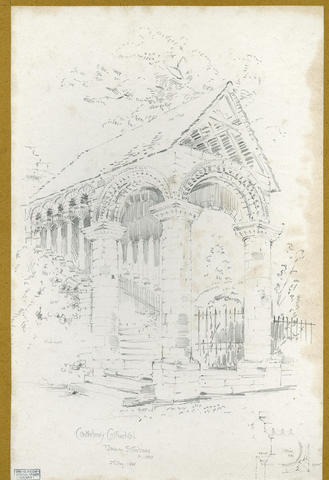License:
 This image is provided under a Creative Commons BY-NC-SA License. You can download this version for private study or non-commercial use. Our terms, conditions and copyright policy (PDF) contains further information about acceptable usage. If you are seeking permission to publish, please contact us ›
This image is provided under a Creative Commons BY-NC-SA License. You can download this version for private study or non-commercial use. Our terms, conditions and copyright policy (PDF) contains further information about acceptable usage. If you are seeking permission to publish, please contact us ›
Please click here if you would like to request a larger, high-resolution version ›
Key Information
Reference code
Title
Date(s)
- 02 Aug 1888 (Creation)
Level of description
Item
Extent
1 item
Content and Structure
Scope and content
Perspective drawing of the Norman staircase at Canterbury Cathedral. The structure is dated 'c. 1080'. Underneath is a small section of a column. The drawing bears the stamp of the Glasgow School of Art Library
Appraisal, destruction and scheduling
Accruals
System of arrangement
General Information
Name of creator
Biographical history
Architect, Glasgow, Scotland. Alexander ('Sandy') McGibbon was born at 11 Pitt Street, Anderston on 5 February 1861, the son of Alexander McGibbon, engine fitter and maritime engineer, and his wife Jane Cameron Selkirk. He was articled to Harry Blair in Glasgow c.1875, studying at Glasgow School of Art and although not mentioned in his nomination paper, his obituary states that he was an assistant in the office of Campbell Douglas & Sellars. In 1882 according to his own account he obtained a place as a draughtsman in the office of John Honeyman and in 1884 was one of the earliest Scottish architects to take the qualifying exam. He was admitted ARIBA on 9 June the same year, his proposers being Honeyman, David Barclay and Campbell Douglas. In 1889 he moved to Burnet Son & Campbell where he is recorded as having worked alongside A N Paterson; the Honeyman & Keppie staff photograph showing him with McNair, Mackintosh and Whitelaw probably commemorated his departure from that office.
In 1890 McGibbon commenced practice on his own account and was appointed to the staff of Glasgow School of Art as assistant to William James Anderson. The census of the following year recorded him as living with his three unmarried sisters: Christina, a teacher; Annie Jane, described as a housekeeper; and Margaret Helen, a music teacher. Of these Annie Jane subsequently married.
In 1893-94 he contributed to 'The Builder' a series of illustrations of the Scottish cathedrals which established his reputation as a brilliant perspective draughtsman, and his practice thereafter was more as perspectivist than architect. Between 1894 and 1920 he maintained an office, at 109 Hope Street from 1894 to about 1905 and at 248 West George Street thereafter. He succeeded William James Anderson as Director of Glasgow School of Art on the latter's death in 1900 with the title of Professor. Harold Hughes who taught with him in 1920-26 provided a sketch of his years at the School:
'As a teacher McGibbon was indefatigable, and there must be very many architects now in practice who can remember with gratitude his inspiring marginal sketches, kind words and his never failing encouragement. He was a tremendous worker. His practice when at the School of Art was to reach the School in the middle of the morning having had a somewhat late breakfast. He stayed without a break till half-past five. Should be become hungry, he would chew nuts, of which he always carried an ample supply in his pocket. At half-past five he would leave for the good old-fashioned Elizabethan dinner, and returned night after night to the School at seven o'clock, where he stayed till ten o'clock. At ten o'clock he would retire to his small private office and make perspective drawings up to two, three or even four o'clock in the morning. His perspectives were turned out with remarkable rapidity, and the accounts rendered for these perspectives were never in proportion to the work he put into them. If he felt a man could not well afford to pay for the perspectives, McGibbon would most certainly forget to send an account'.
McGibbon retired in 1926 when his portrait was painted by Maurice Greiffenhagen. He never married. Although big-built he was short in stature, the hem of his coats being just above his toecaps. His main interest outwith the profession was St George's Church where he was an elder for 49 years, superintendent of its Sunday school and Convener of its St Michael's Mission Committee. He died of myocarditis at his house, 51 Kessington Road, Bearsden on 5 December 1938.
Archival history
Custodial history
Physical Description and Conditions of Use
Conditions governing access
Conditions governing reproduction
Language of material
Script of material
Language and script notes
Physical Description
Pencil on cartridge paper.
Dimensions: 418 x 277 mm
Finding aids
Related Material
Existence and location of originals
Existence and location of copies
Related materials
Notes area
Alternative identifier(s)
Keywords/Tags
Subjects
Place access points
People and Organisations
Genre access points
Status
Level of detail
Processing information
Language(s)
Script(s)
Sources
Digitised item metadata
Filename
NMC_1726RRR.jpg
Latitude
Longitude
Media type
Image
Mime-type
image/jpeg


